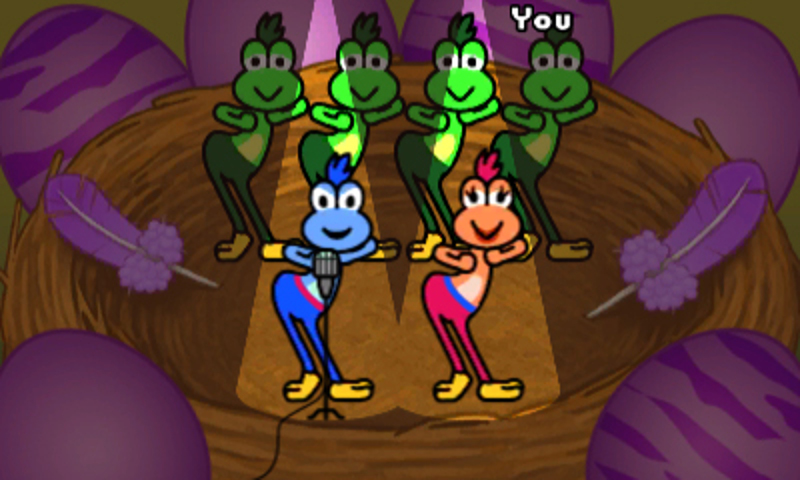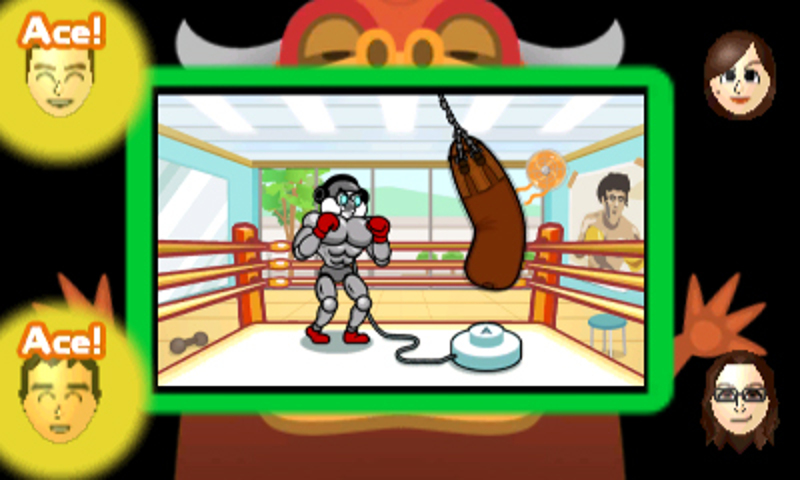Look, if you’re not a fan of rhythm games, then you might as well stop reading now. But then you’ll miss out on what could possibly be described as the gateway drug to rhythm games. If this intrigues you in even the slightest, come feel the beat with me as I review Rhythm Paradise Megamix for the Nintendo 3DS.
Full disclosure: I am a huge, huge fan of the Rhythm Paradise series (also known as Rhythm Heaven in the US, and Rhythm Tengoku in Japan), to the point where I imported the original games. The music has always been great, and the game’s art style has always been a treat to look at. The first game, Rhythm Tengoku for the Nintendo Gameboy Advance, never made an appearance outside of Japan, but was a massive success over there. It was enough of a success that a followup was released for the Nintendo DS. As is the nature of these things, Rhythm Paradise never made it to South African shores, and neither did its Wii followup, Beat the Beat: Rhythm Paradise. This then explains why I had to go to such lengths to play these games, and I never understood its lack of popularity here: they’re excellent games that were all exceedingly well received.

To address all those people who missed the original games (i.e. most of South Africa), here comes Rhythm Paradise Megamix, a game that not only gives you a unique Rhythm Paradise experience, but also allows you to experience most of the rhythm minigames that came out of those past three. To describe these games as exceedingly quirky in the most Japanese way possible would be a slight understatement. None of the rhythm games have much at all to do with each other, and they all have you doing some exceedingly odd stuff; or comparably normal activities, but with a twist. And there are a lot of monkeys. Passing the rhythm games starts out as an easy process, but the difficulty ramps up quickly, especially if you have a hard time keeping count of beats and rhythms, and even more especially if you struggle with the off-beat. I’m looking at you, Lockstep.

Unlike the first few games, Rhythm Paradise Megamix features a story. A character named Tibby has fallen from Heaven World, and with your help, and the help of clearing rhythm minigames, you need to get Tibby back up to where he belongs. A number of very odd characters will help you in your journey, but you must help them each first by completing more minigames. Clearing each song nets you coins–the better you do, the more coins you obtain. In between sets of minigames, a trio of colorful sages will appear and will present you with a rhythm challenge, which they charge you coins for. Early on, these challenges are painful to take on because coins are in such short supply, and every time you fail, you have to pony up again to retake it and hope you succeed before you can proceed. The story segments, thankfully, never have to be repeated once you’ve unlocked the music and minigames; you can go directly to the song you want to play through.
The most fun part of any Rhythm Paradise game has always been the remixes, which take the set of songs from the stage you’re in and puts them together into a whole new song using all the minigame mechanics in that stage. Later stages use more variety, pulling in mechanics from older stages. The remixes are designed to keep you well on your toes, and they’re no less tricky in Rhythm Paradise Megamix. Because it’s a game aimed at newer players, though, you’re only presented with your first remix almost 30 songs into the game, and none of the remixes are from prior games. For contrast’s sakes, Rhythm Tengoku gives you your first remix after the fifth song, and both Rhythm Paradise and Beat the Beat give you the first remix after the fourth song (to a total of ten remixes for the latter two games). Rhythm Paradise Megamix doesn’t number the remixes, sadly, so you have to refer to them with such strange names as “Remix Honey Bee” or “Remix Tree”. It doesn’t quite have the same effect when you’re trying to tell your friends how awesome you are at said remixes.

The minigames in Rhythm Paradise Megamix seem to feel a lot gentler and a heck of a lot more forgiving than before. Either that, or I’ve just become that good at playing Rhythm Paradise. I breezed through the game, probably due to a combination of knowing the music and muscle memory. Rhythm Paradise Megamix eschews the “flick” motion from the DS’s Rhythm Paradise, and confines you you to taps or button presses alone. Naturally, this means that some games would be nigh impossible to put into this collection, including my personal favourites, Love Lab and Rockers (although Love Lab seems to have been replaced in musical spirit by a game called Slumber Party). On the other hand, most of the games from the other two made it through unscathed. I found that muscle memory failed me when I switched to a control mode I wasn’t familiar with, for example if I used buttons instead of stylus for Frog Hop. Of the newer songs, the ones I liked least were the new, easier takes on existing minigames. I felt a lot of those to be horridly inferior to the originals. This is counter-pointed by the new songs, which I felt had that same earwormy catchiness as the originals.
Rhythm Paradise Megamix has three specific features that place it well beyond its predecessors. The first is the indicator on the lower screen that tells you how off-beat your timing is. Better timing = more points, so nailing this is critical. The second thing is that the scoring is de-obfuscated. At the end of each minigame, a meter tells you exactly how well you did. Getting a score of a perfect 100 is almost impossible though–this would require you to tap or press perfectly on every beat during the entire minigame, but I feel that this isn’t quite the point. It’s a way of gradually improving yourself. Or bragging to friends. The last feature is probably overlooked, but its absence in prior games is something I missed a lot: a way of restarting the song without quitting back to the song menu and going through the practise round again. Also, any song you’ve already completed gives you the chance to skip the tutorials for it by pressing X instead of A. Many bonus points for those inclusions!

There’s also a multiplayer section, where you and up to three other friends can attempt to pass challenges. You literally board the fail train, and are presented with three songs to pass under specific conditions, for example pass with a score of more than 70, or get through the level in three lives. At the end of the song, your combined scores are tallied and averaged, and if you don’t meet the conditions, your train takes damage. Three strikes and you’re out. This mode is actually a lot more fun than you’d think. Since you and your friends are in it together, there’s a lot of impetus to do well, and missed beats are met with wailings and moanings and gnashings of teeth.
I doubt that you’d have made it this far if you hated rhythm games, so before I close the review, it’s only fair you get a taste of the music in this game.
There’s a lot of music, and veterans will find that the new stuff is worth the price of entry. Hell, the old stuff is still enjoyable to listen to and I’ve had years of playing these games and listening to the same music, and I still haven’t mastered some of these challenges. And for those who are true fans, you’ll be able to switch between the English and Japanese versions of the songs. Get it. It’s just that much fun.



